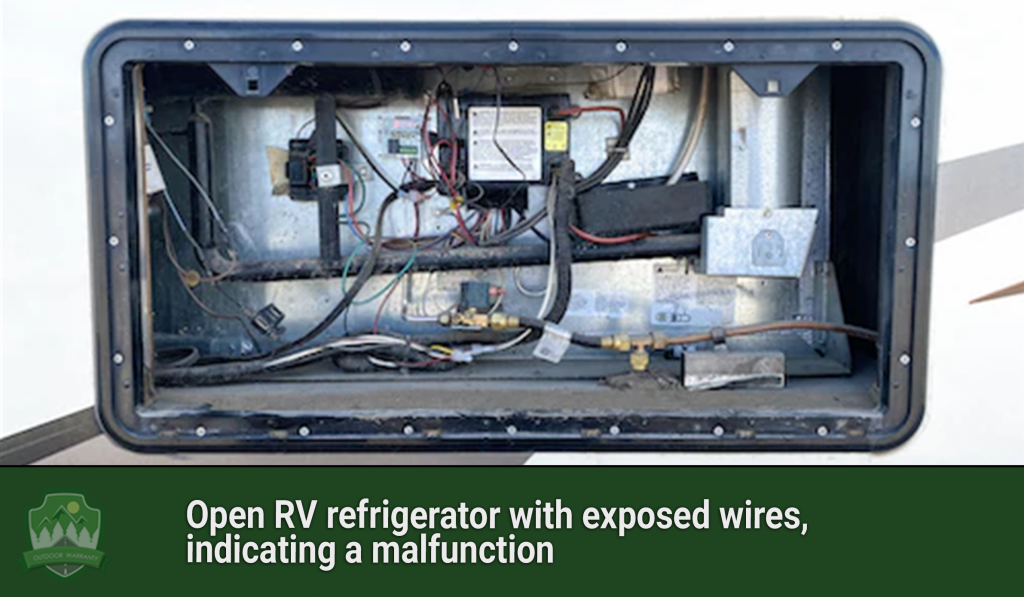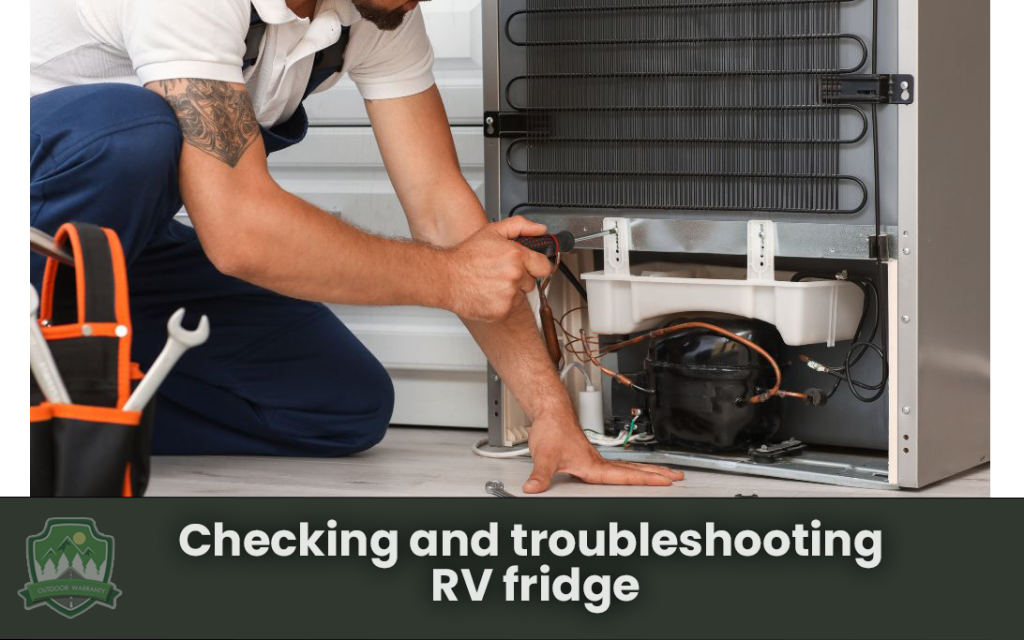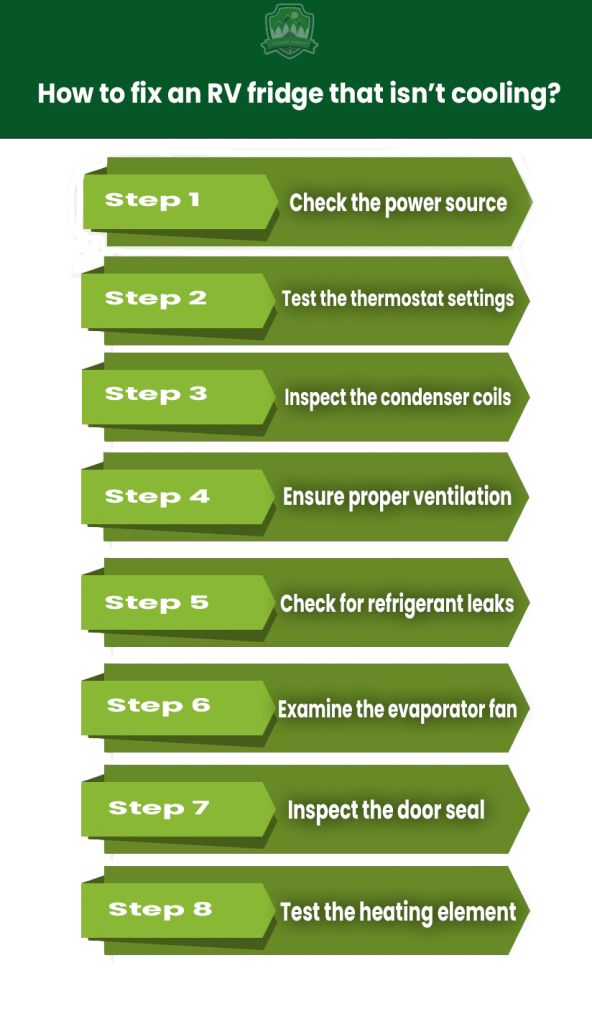
Table of Contents
RV Fridge Not Cooling (RV Refrigerator Not Working) is a common issue RV owners face. Check the power source first, as electric and propane failures disrupt cooling. A malfunctioning power supply, whether the electrical connection or propane system, prevents the fridge from reaching the desired temperature. The RV fridge does not work if it does not receive power, resulting in spoiled food and wasted energy.
The RV refrigerator not cooling involves several factors, such as parking the RV in direct sunlight areas, proper ventilation, and if there’s any blockages or issues with the airflow. For example, an unlevelled fridge struggles to maintain the right temperature. Keeping vents clear and ensuring sufficient air circulation helps maximize cooling efficiency. Regular maintenance, such as cleaning the condenser coils, supports optimal performance.
The cost of repairing a camper fridge not working depends on the nature of the issue. Replacing components like the thermostat, control board, or heating element is less expensive than replacing the entire unit. Repairing a damaged cooling unit costs more than buying a new fridge. Replacement of the fridge is the most cost-effective solution.
Warranties play a crucial role in determining the cost of repairs or replacement. Extended warranties cover repairs for mechanical failures but exclude wear and tear. A fridge’s cooling performance takes four to twelve hours to stabilize when troubleshooting, depending on its size, environment, and power source. A professional technician or the fridge’s owner’s manual guide specific problems and solutions.

Why is my RV refrigerator not cooling?
Reasons why your RV refrigerator is not cooling are listed below.
- Power supply issues: A malfunctioning or disconnected power source prevents the refrigerator from operating. Faulty electrical outlets, fuses, or wiring cause the problem.
- Blocked ventilation: A blocked ventilation system restricts airflow to the refrigerator. Overheating occurs, which disrupts cooling.
- Thermostat problems: A faulty thermostat causes incorrect temperature readings or fails to initiate cooling cycles.
- Damaged compressor: A malfunctioning or damaged compressor prevents the refrigerator from cooling. The compressor is responsible for circulating coolant.
- Refrigerant leaks: A refrigerant leak leads to a drop in cooling efficiency. The refrigerator is not cool because of insufficient coolant.
- Dirty condenser coils: Dust and dirt accumulation on condenser coils impair heat dissipation, leading to inefficient cooling.
- Evaporator fan failure: A failure of the evaporator fan results in insufficient cooling. The evaporator fan circulates cool air inside the fridge.
- Broken heating element: A broken heating element causes the refrigerator not to cool.
- Defective control board: A malfunctioning control board stops the unit from cooling. The control board manages the refrigerator’s operations.
- Damaged door seal: A damaged door seal allows warm air to enter the refrigerator, reducing its cooling efficiency.
A blocked airflow in the refrigerator section prevents proper cooling while the freezer remains functional due to an obstructed evaporator fan or air ducts. A malfunctioning thermostat or incorrect temperature settings contribute to cooling issues. Low refrigerant levels or leaks reduce cooling efficiency and allow the freezer to function. A dirty condenser coil or obstructed venting around RV refrigerators makes cooling difficult in hot weather. High external temperatures strain the system, leading to overheating and cooling failure. Refrigerant leaks worsen in extreme heat, further reducing efficiency. RV refrigerators are designed for a specific temperature range, and extreme conditions overwhelm their capacity.

How do I check if my RV fridge is working properly?
Checking your RV fridge must be tested for proper operation by measuring the temperature. A thermometer measures the internal temperature of the refrigerator and the freezer compartments. The fridge must be around 37 to 40 degrees Fahrenheit, while the freezer must be at 0 degrees Fahrenheit. The temperature has to be adjusted if it is outside the ranges.
The next step is to check for airflow blockages. Ensure that the vents inside and outside the fridge are not obstructed. Blockages prevent the refrigerator from cooling correctly, causing uneven temperatures. Verify sufficient clearance in the condenser area around the refrigerator for proper ventilation.
A final inspection must be conducted on the power sources to ensure their functionality. The RV Motorhome fridges operate on electric, propane, or battery power. Check that the power supply to the refrigerator is active and stable. Test the electrical connection, ensure the propane valve is open, and confirm the battery is charged. The refrigerator suffers from cooling problems if there are problems with the power sources.

How to fix an RV fridge that isn’t cooling?
To fix an RV fridge that isn’t cooling, follow eight steps below. 👇
- Check the power source. Ensure the fridge is connected to electricity, propane, or battery. Test each power source for functionality.
- Test the thermostat settings. Adjust the thermostat to the correct temperature. Consider replacing the fridge’s thermostat if it continues to malfunction.
- Inspect the condenser coils. Clean dirt or debris from the condenser coils. Dirty coils reduce cooling efficiency.
- Ensure proper ventilation. Clear obstructions around the fridge vents. Adequate airflow is essential for the fridge to cool.
- Check for refrigerant leaks. Look for signs of a refrigerant leak. A technician must recharge the refrigerant if a leak is found.
- Examine the evaporator fan. Confirm that the evaporator fan is working. Replace the fan if it is not circulating air properly.
- Inspect the door seal. Ensure the door seal is intact and not damaged. A broken seal allows warm air to enter, reducing cooling efficiency.
- Test the heating element. Check the heating element for functionality if the fridge uses an absorption system. Replace it if defective.

Why is my RV fridge not cooling on electric?
Read More
Your RV fridge is not cooling on electric because the fridge is not plugged in or receiving power. Check the power cord and electrical connections to ensure they are secure and functional. Another possible cause is a tripped breaker or blown fuse. Inspect the electrical panel, reset the breaker, or replace the fuse. A damaged heating element is the problem. A malfunctioning element prevents the refrigerator from cooling on an electric fridge for RV. Replacing a damaged heating element is necessary to restore cooling.
Why is my RV fridge not cooling on propane?
Read More
Your RV fridge is not cooling on propane because the tank is empty or turned off. Confirm that the tank has fuel and is turned on. Check the igniter and burner for dirt or blockages if the propane supply is sufficient. A clogged burner or faulty igniter prevents the propane from igniting, stopping the cooling process. Cleaning debris or replacing a damaged igniter restores proper functionality. Proper propane flow is crucial for the fridge to operate.
How do I switch my RV fridge from electric to propane?
Read More
Switching your RV fridge from electric to propane by checking its switch type. Fridge models automatically detect power sources and switch between electric and propane, while others require manual adjustment. Locate the power source selector on the fridge and select propane mode.
Ensure the propane supply is turned on. Confirm that the propane tank has sufficient fuel and the valve is open. The igniter must be checked for functionality. An unresponsive igniter prevents the fridge from lighting the burner and cooling.
Check the flame to ensure the propane switch is successful. The RV fridges have a small observation window to view the flame. Blue flames indicate a burner that is functioning. Troubleshoot the igniter or burner if there is no flame visible. Check for blockage or malfunctions.
Can a low battery affect my RV fridge cooling?
Read More
Yes, a low battery can affect your RV fridge cooling. RV fridges rely on 12V power to operate the control board, which manages the fridge’s functions. The fridge’s cooling system malfunctions if the battery is low. Symptoms of a low RV battery impacting the fridge include inconsistent cooling, where the refrigerator does not maintain a stable temperature, or the failure to switch between electric and propane modes. A refrigerator does not function in such cases, leading to cooling issues.
How can I improve RV fridge cooling performance?
You can improve RV fridge cooling performance by parking in shaded areas to reduce heat exposure. Direct sunlight increases the temperature around the fridge, making it harder for the cooling system to maintain the desired temperature. Parking in shaded spots helps keep the fridge cooler, allowing it to function more. Ensure proper ventilation behind the fridge. Blocked vents or insufficient airflow lead to overheating and reduce cooling effectiveness. Check that the vents are clear and the refrigerator has enough space around it for adequate air circulation. Proper ventilation helps the fridge operate at its best performance.
What temperature should an RV fridge be set at?
The temperature in an RV fridge should be set at 34-40°F (1-4°C) for the fridge compartment and 0°F (-18°C) for the freezer. The settings are optimal for food preservation and fridge efficiency. Thermometers are essential for verifying the actual temperature inside the fridge and freezer. The built-in thermostat does not always provide an accurate reading due to factors such as door openings or external temperature changes. A thermometer ensures precise control, maintaining food safety and the fridge’s peak performance.
How do I keep my RV fridge cold while traveling?
Keep your RV fridge cold while traveling by following the seven steps listed below. 👇
- Pre-cool the fridge. Set the fridge to the desired temperature before starting the journey. Allow the fridge to cool down for several hours or overnight.
- Pack the fridge with pre-chilled items. Load the fridge with cold or frozen food. The lower temperature was maintained for more extended periods.
- Close the fridge door as much as possible. Limit the number of times the door is opened. Warm air enters when the door is opened, raising the internal temperature.
- Use a cooler for extra storage. Keep accessed items in a separate cooler. The result reduces the need to open the RV fridge.
- Ensure proper ventilation. Make sure the fridge vents are not obstructed. A good airflow helps the cooling system work more effectively.
- Keep the RV fridge in a shaded area. Park in a shaded spot to prevent direct sunlight from increasing the temperature around the fridge.
- Check the power supply. Ensure the fridge is connected to the power source (electric, propane, or battery) and functions correctly throughout the trip.
Can an RV fridge cooling system be repaired?
Yes, an RV fridge cooling system can be repaired. Repairs are possible when specific components, such as the control board or heating element, fail. The parts replaced to restore functionality. Faulty control boards prevent the fridge from regulating temperature, while damaged heating elements disrupt absorption. Cooling units need replacing. Condensers and evaporators are at fault when the system is broken or inefficient. Replacing a cooling unit is expensive and not always the best option.
How much does it cost to fix an RV fridge that won’t cool?
Fixing an RV fridge that won’t cool costs around $100 to $300 for a thermostat replacement. Repairing or replacing the control board ranges from $200 to $500. The cost of changing a cooling unit depends on the brand and complexity, ranging between $800 and $2,500. Replacing the RV fridge costs from $1,000 to $3,000 or more. Repair costs are lower than replacing the whole fridge, when the issue is with components like the thermostat or control board. A new cooling unit costs as much or more than a new fridge.
When should I replace my RV fridge?
Read More
You should replace your RV fridge when the cost of repairs exceeds half the price of a new unit. The lifespan of an RV fridge is 10 to 15 years, and after that the fridge experiences increased breakdowns or reduced efficiency. Persistent cooling issues, such as failure to maintain the desired temperature or ammonia leaks, which indicate a problem with the cooling unit, are strong signs that replacement is necessary. The most economical option is to replace the fridge if the issues persist despite repair attempts or if repairs become too expensive.
Why is my RV freezer cold but not the fridge?
Read More
Your RV freezer is cold but not the fridge because of airflow issues between the two compartments. Poor air circulation prevents the fridge from cooling while the freezer continues functioning. Ice blockages or frost buildup in the vents or freezer compartment obstruct airflow, which makes it difficult for the fridge to maintain the right temperature. Temperature regulation in the fridge was affected by a malfunctioning thermistor, which caused the issue. The thermistor fails to signal the cooling system to cool the fridge compartment if it is not working, leaving the freezer unaffected.
Why is my RV freezer not freezing properly?
Read More
Your RV freezer is not freezing properly because the fridge is not level. Improper leveling affects the cooling system’s efficiency, leading to inconsistent freezing. The thermostat or control board malfunction, preventing the freezer from reaching the correct temperature. A faulty thermostat fails to regulate the cooling process, while a damaged control board disrupts the fridge’s performance. Inspecting and addressing the issues restores proper freezing functionality in the RV freezer.
How long does it take for an RV fridge to get cold?
Read More
It takes 4 to 12 hours for an RV fridge to get cold. The time needed depends on factors like the size of the fridge, the initial temperature inside, and the surrounding environment. The fridge must be turned on the night before a trip for optimal cooling. Taking the step allows sufficient time for the fridge to reach the correct temperature, ensuring it works during the journey.
Do Extended Warranties Cover RV Refrigerators?
Read More
Yes, extended warranties do cover RV refrigerators. The coverage depends on the warranty provider and the specific plan. Mechanical failures are covered, but wear and tear is not included. The Extended Warranty for RVs focuses on significant issues like compressor or cooling unit malfunctions, but normal aging or minor cosmetic issues are not covered. Reviewing the warranty terms is essential to understanding the specific coverage details and exclusions.
Does RV Freezer Get Cold Before Fridge?
Read More
Yes, an RV freezer does get cold before the fridge. Absorption fridges are designed to cool the freezer section first, as it requires a lower temperature to freeze food. The cooling process relies on the flow of cold air from the freezer into the fridge compartment. Considering that cold air flows downward naturally, the freezer section cools first, followed by the fridge. The airflow process influences how the cooling distribution works, with the freezer becoming cold more quickly while the fridge reaches its optimal temperature.